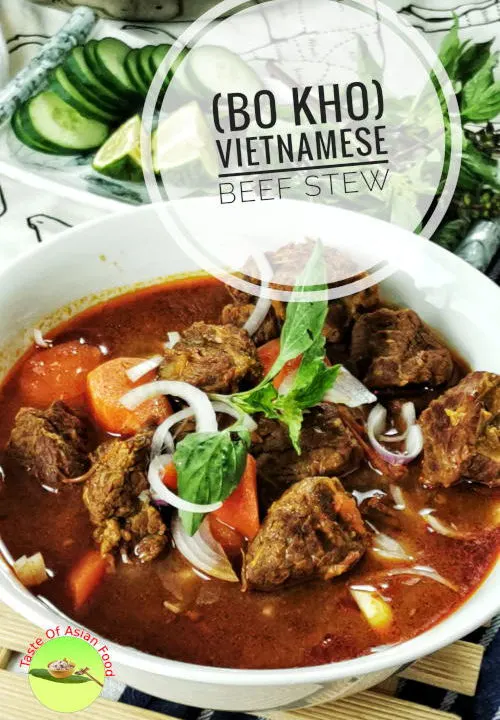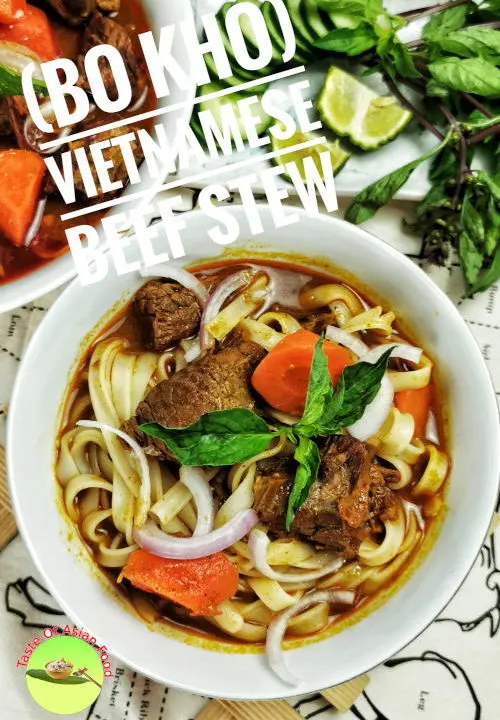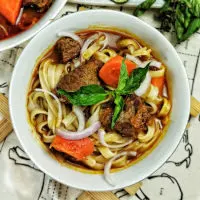What makes Bo Kho (Vietnamese beef stew) stand out from the rest?
The unique flavor!
If you prepare beef stew with rosemary, thyme, and paprika, make a change by replacing them with lemongrass, fish sauce, coconut juice, and basil leaves!
This article will explain how to prepare Bo Kho in detail.
If you live in other parts of the world, you miss out on not trying this recipe.
Let’s get into the details right now.
Note: This post may contain affiliate links. Please read my privacy policy for more info. I may receive commissions for purchases made through links in this post. As an Amazon Associate, I earn from qualifying purchases.

How to prepare Bo Kho
I have divided the Vietnamese beef stew recipe into five sections:
1. Marinate and sear the beef
Which beef cuts are best for Vietnamese Beef Stew?
If you order a bowl of Bo Kho at the restaurant, you are likely to have a choice of the cut of beef (chucks, shanks, flanks, tendon, and oxtails)
I have a small family, so I will leave out the beef tendon and other cuts and only use beef chucks in this Vietnamese beef stew recipe.
Marinate the beef
- Remove the thick, slivery layer on the surface. It is tough and should be removed before cutting it into small pieces.
- Wipe the beef with a dry kitchen towel to remove as much water as possible. It will not brown effectively if the beef is wet in the following step.
- Cut the beef into 1.5-inch chunks. Keep in mind that the beef will shrink after cooking, so you should consider the shrinkage when cutting the beef.
- The beef is marinated sugar, salt, black pepper, and fish sauce. You may come across some Vietnamese beef stew recipes adding finely chopped lemongrass into the marinade. Also, since the broth has lemongrass in it, I will leave it out in the marinade. Some Bo Kho recipes also use soy sauce instead of fish sauce. However, I like the flavor of fish sauce, so I will not replace it with soy sauce.
- I think the meat of 1.5-inch in size should at least marinate for an hour to enable the flavor to penetrate effectively into the interior. It is even better to keep it in the refrigerator overnight if you have time.
Brown the beef
- Although you can stew the marinated beef with the broth, it will taste better if you brown it first.
- Browning the beef creates extra flavor, which is essential if you seriously want to make a high-quality Vietnamese beef stew.
- Since the goal is to brown the surface and not cook the beef, the heat should be medium to high heat. You can use a well-seasoned cast-iron skillet or a non-stick pan, which will drastically reduce the problem of the meat sticking to the surface while browning.
- Drain the beef from any excess marinade to keep it as dry as possible. The drier it is, the quicker the browning will take place. You can also remove the excess liquid exude from the beef during browning to keep the skillet dry to speed up the browning process. This liquid is the extract of the meat, which will be added to the broth later.
- Once the surface of the beef chunks has turned brown, remove and set aside. There is no need to cook through the meat.
2. Stew the beef with a blend of spices and herbs
- Heat some vegetable oil in a pan, and saute the chopped garlic, ginger, and bashed lemongrass. These items should be treated separately from the beef. The duration and timing of browning the beef are different from the aromatics. The garlic and ginger may have burnt by leaving in the pan for too long.
- Add the annatto powder and Bo Kho spices to the pan. I have a short note following this section about annatto powder and Bo Kho spices and the suitable substitutes.
- Place the browned beef into the pan and mix with all the ingredients. Cook until it is dry, and the spices well coat the beef chunks for about two minutes. That will allow the pigment from the annatto powder to color the beef, which turns it slightly red. If you add the annatto powder after including the broth into the pot, the meat will not effectively be colored by the pigment.
- Rough chop a tomato and add to the pan. The tomato will provide some liquid so that the spices will not get burnt. Alternatively, you can replace it with a large tablespoon of tomato paste.
- Now include the dry spices (cinnamon, bay leaves, star anise) and the bashed lemongrass.
Depending on your pan/skillet size, you may need to transfer the beef stew to a larger pot before adding sufficient water to stew it. Add water to just enough to cover half of the beef chunks and wait until it comes to a boil. Then turn down the heat to keep the stew at a slow simmer for one to two hours, or until the beef is tender.
The time required depends on the size and cut of beef and whether you use a slow cooker, stovetop, or pressure cooker. The endpoint is the meat tender, but not until it will disintegrate into meat floss!
What is annatto powder?
- Annatto is a condiment and natural coloring derived from the seeds to impart a yellow or orange color, flavor, and aroma to foods.
- It has a slightly peppery, nutty with a hint of nutmeg flavor.
- It is sold in the form of powder or whole seeds. The powder is added to the soup or stew directly to give the color and flavor. If you use the seeds, you can extract the color and flavor with hot oil, discard the seeds and add the oil to the food.
- If it is not available, substitute it with tomato paste or paprika powder to some color to the beef stew since Bo Kho should have a red tinge.
What is Bo Kho spice?
- Bo Kho spices are a combination of paprika, star anise, garlic, chili, ginger, and cloves. Some brands also include part of the annatto powder as one of the components.
- The closest substitute is Chinese five-spice powder.

3. Add the vegetables
The most common root vegetable for Bo Kho is carrot, although daikon and potatoes are also included in some Vietnamese beef stew recipes.
I will keep my Bo Kho recipe simple by only using carrots.
- Cut the carrots in wedges, about the size of the beef chunks.
- When the beef has become tender, add the carrot and continue stewing for twenty minutes.
- Add one cup of coconut water to the stew. I can quickly get fresh coconut juice in Malaysia. You can use those in the tetra pack if it is not available. Please note that it is coconut water, not coconut milk! If you can’t get any coconut water, substitute it with plain water and a teaspoon of sugar.
- You have the choice to add more water to make it soupier or less to become a stew. Therefore, you need to do a taste test to adjust the flavor since the amount of liquid may not be the same every time. Then, adjust the flavor with more salt, sugar, and more Bo Kho spices until you are satisfied with the taste.
- The stew will be thicker if you use potatoes since it contains starch. However, you can add some cornstarch to thicken it if you only use carrot or daikon. In this case, mix a teaspoon of cornstarch with two tablespoons of cold water to form a slurry to thicken the stew.
4. Garnish, storage and serve
The Vietnamese beef stew is usually served with some basil leaves, lime wedges on the side, and garnished with basil leaves and raw onions slices on top.
It can be a standalone meal, but more often with noodles and with your crusty Vietnamese baguette, bánh mì.
Since Bo Kho is a stew with beef, you expect it tastes even better if you keep it overnight or longer after the flavor infuses thoroughly into the meat. Therefore, it is worth making a larger batch and keep some portions in the freezer.
Bo Kho holds up well in the freezer without the carrot. Therefore, I suggest removing the portion you want to freeze right up to the step before adding the carrot. When you want to enjoy Bo Kho later, defrost and continue the last step of adding the carrots.
Other related recipes to Bo Kho
Here is my top pick of some related recipes on this blog.
Have you ever tried chicken thighs infused with lemongrass flavor? If you want to throw in some Asian flavor apart from the typical soy sauce-based Chinese cuisine, this Vietnamese-inspired pan-fried lemongrass chicken chop will guarantee to be a total crowd-pleaser.
Chinese beef stew. This beef stew recipe involves traditional Cantonese seasonings, which tastes very different from the Vietnamese-style beef stew. Give it a try to taste the difference.
Three cups chicken is so attractive because of its simplicity to prepare and intense flavor. If you never try Taiwanese food before, always start with three cups chicken.

Bo Kho (Vietnamese beef stew) - How to cook to get the best result
What makes Bo Kho (Vietnamese beef stew) stand out from rest?
The unique flavor!
If you prepare beef stew with rosemary, thyme, and paprika, make a change by replacing them with lemongrass, fish sauce, coconut juice, and basil leaves!
This article will explain how to prepare Bo Kho in detail.
If you live in other parts of the world, you miss out on not trying this recipe.
Ingredients
Ingredients A (marinate the beef)
- 1kg beef
- 1 tsp sugar
- 1 tsp salt
- 1/2 tsp black pepper
- 2 tbsp fish sauce
Ingredients B (saute))
- 2 tbsp vegetable oil
- 1 tbsp chopped garlic
- 1 tbsp chopped ginger
- 2 tsp annatto powder
- 2 tsp Bo Kho spices
Ingredients C (for the broth)
- 1 large tomato, coarsely chopped
- 4 lemongrass, bashed
- 1 cinnamon stick
- 2 star anise
- 2 bay leaves
- 1.5 liter water
- 2 carrots, cut into wedges
- 1 cup coconut water
- Cornstarch slurry (1 tsp cornstarch + 2 tbsp cold water)
Ingredients D (as garnish and topping)
- 1 large onion, cut into slices
- Basil leaves
- Coriander leaves
- Lime wedges
Instructions
- Remove the thick, slivery layer on the surface of the beef..
- Wipe the beef with a dry kitchen towel.
- Cut the beef into 1.5-inch chunks.
- Marinated with sugar, salt, black pepper, and fish sauce for half a day.
- Brown the beef on both sides over medium heat.
- Heat some vegetable oil in a pan, and saute the chopped garlic, ginger.
- Add the annatto powder and Bo Kho spices.
- Place the browned beef into the pan and mix with all the ingredients. Cook until it is dry.
- Rough chop a tomato and add to the pan.
- Now include the dry spices (cinnamon, bay leaves, star anise) and the bashed lemongrass.
- Add water to just enough to cover half of the beef chunks. Simmer for one to two hours, or until the beef is tender.
- When the beef has turn tender, add the carrot and continue stewing for twenty minutes.
- Add one cup of coconut water to the stew.
- Do a taste test to adjust the flavo with more salt, sugar, and Bo Kho spices.
- Thicken the stew with the cornstarch slurry.
- Garnished with basil leaves and raw onions slices on top.
Recommended Products
As an Amazon Associate and member of other affiliate programs, I earn from qualifying purchases.
-
 Pre-Seasshioned Cast Iron Skillet 2-Piece Set (10-Inch and 12-Inch) Oven Safe Cookware - 2 Heat-Resistant Holders - Indoor and Outdoor Use - Grill, Stovetop, Induction Safe
Pre-Seasshioned Cast Iron Skillet 2-Piece Set (10-Inch and 12-Inch) Oven Safe Cookware - 2 Heat-Resistant Holders - Indoor and Outdoor Use - Grill, Stovetop, Induction Safe -
 Oriental Vietnamese Beef Stew Spices Seasoning (Pack of 3) - Gia Vi Nau Bo Kho
Oriental Vietnamese Beef Stew Spices Seasoning (Pack of 3) - Gia Vi Nau Bo Kho -
 Badia Annatto Ground 2.75 Oz
Badia Annatto Ground 2.75 Oz -
 C2O Pure Coconut Water, 33.8 oz
C2O Pure Coconut Water, 33.8 oz
Nutrition Information:
Yield: 4 Serving Size: 1Amount Per Serving: Calories: 1038Total Fat: 57gSaturated Fat: 20gTrans Fat: 0gUnsaturated Fat: 29gCholesterol: 218mgSodium: 1549mgCarbohydrates: 60gFiber: 4gSugar: 7gProtein: 70g
This data was provided and calculated by Nutritionix on 6/28/2021

BÒ KHO: stoofpot van rundvlees met wortelen - Vlakbij de Molen
Friday 7th of November 2025
[…] is in Nederland niet te koop. Wel deze Bò Kho bouillon blokjes van het merk Bao Long. Hier een voorbeeld van zo’n recept. Je voegt dat Bò Kho poeder (en eventueel ook het anatto poeder) dus toe voordat de tomatenpuree […]
KP Kwan
Tuesday 29th of June 2021
Hi, this is KP Kwan. I am happy to see you in this comment area as you have read through my recipe. I am pleased to reply to any questions and comments as soon as possible.